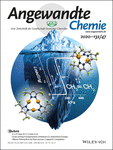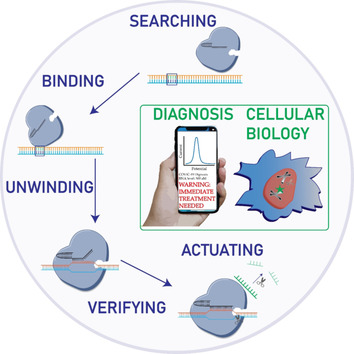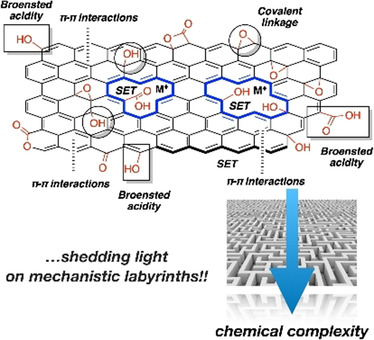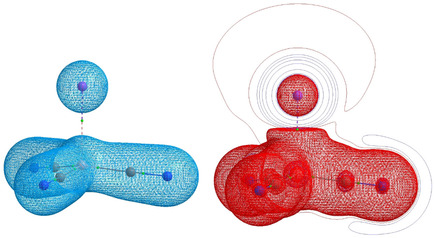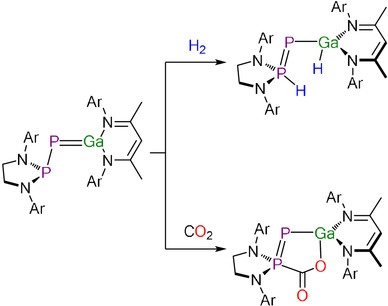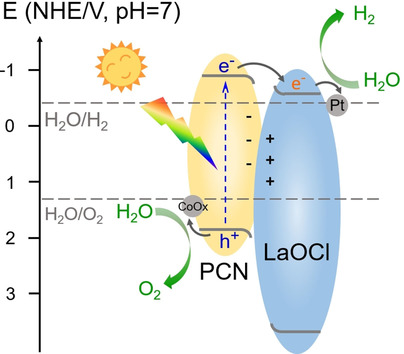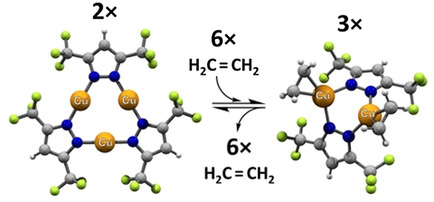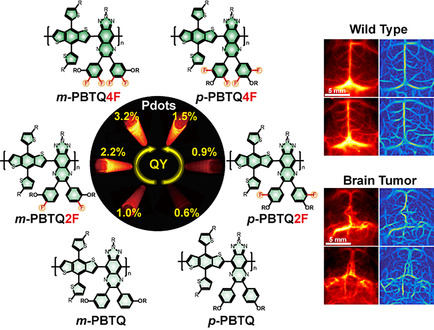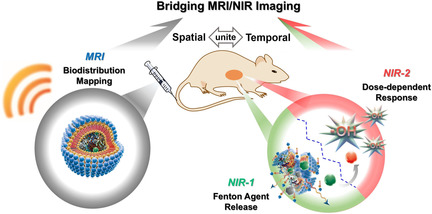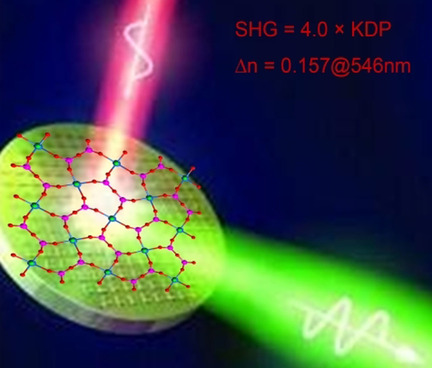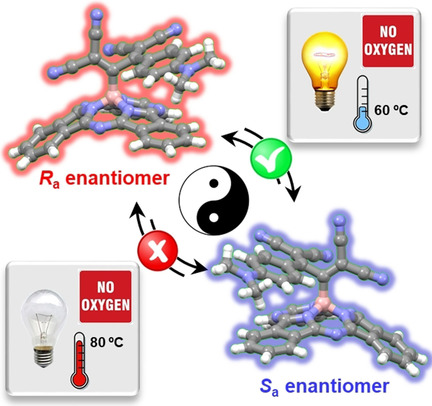Journal list menu
Export Citations
Download PDFs
Titelbild
Titelbild: Overcoming Fundamental Limitations in Adsorbent Design: Alkene Adsorption by Non-porous Copper(I) Complexes (Angew. Chem. 47/2020)
- Page: 20897
- First Published: 29 September 2020

Das Eisberg-Motiv illustriert, wie H. V. R. Dias, M. G. Cowan et al. in ihrem Forschungsartikel auf S. 21187 Lösungschemie in einer Festkörperreaktion für die Trennung von Alkenen und Alkanen nutzen. In-situ-PXRD wurde verwendet, um die reversible Trimer-zu-Dimer-Umwandlung im Festkörper zu verfolgen, bei der multiple Bindungen gebrochen und neu gebildet werden. Die schnelle Aufnahme und Freisetzung und minimale Adsorptionswärme sowie die Wiederverwendbarkeit dieser Materialien machen den Prozess zu einer nachhaltigen Alternative zu Destillationsmethoden.
Innentitelbild: Kooperative Zusammenarbeit von N-heterocyclischen Carbenen auf einer Goldoberfläche (Angew. Chem. 47/2020)
- Page: 20898
- First Published: 29 September 2020
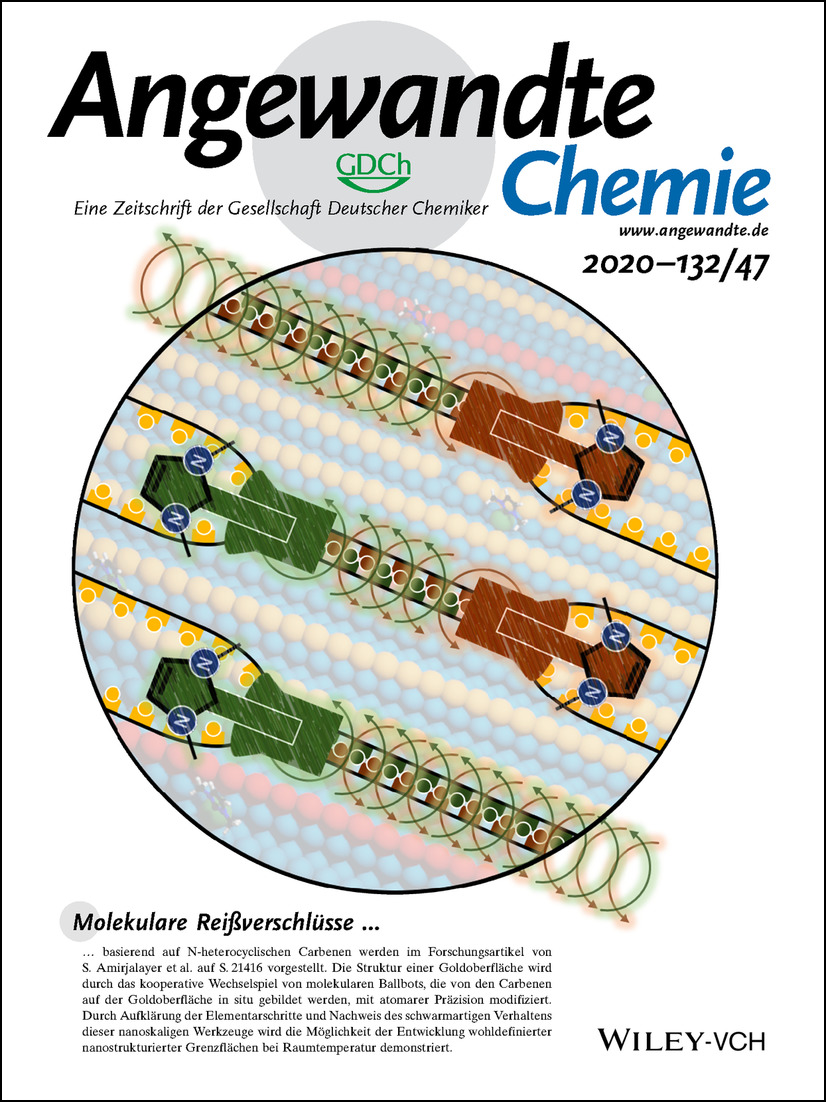
Molekulare Reißverschlüsse basierend auf N-heterocyclischen Carbenen werden im Forschungsartikel von S. Amirjalayer et al. auf S. 21416 vorgestellt. Die Struktur einer Goldoberfläche wird durch das kooperative Wechselspiel von molekularen Ballbots, die von den Carbenen auf der Goldoberfläche in situ gebildet werden, mit atomarer Präzision modifiziert. Durch Aufklärung der Elementarschritte und Nachweis des schwarmartigen Verhaltens dieser nanoskaligen Werkzeuge wird die Möglichkeit der Entwicklung wohldefinierter nanostrukturierter Grenzflächen bei Raumtemperatur demonstriert.
Innenrücktitelbild: Multiexcitonic Triplet Pair Generation in Oligoacene Dendrimers as Amorphous Solid-State Miniatures (Angew. Chem. 47/2020)
- Page: 21431
- First Published: 09 November 2020
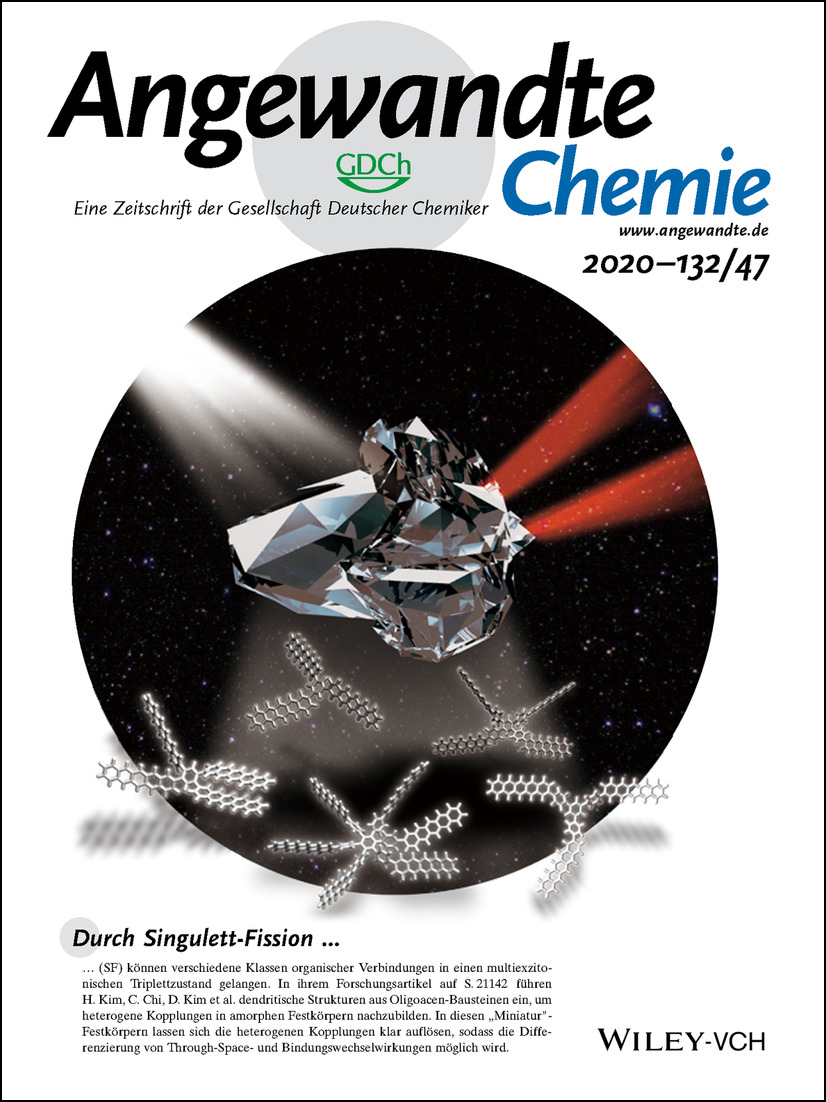
Durch Singulett-Fission (SF) können verschiedene Klassen organischer Verbindungen in einen multiexzitonischen Triplettzustand gelangen. In ihrem Forschungsartikel auf S. 21142 führen H. Kim, C. Chi, D. Kim et al. dendritische Strukturen aus Oligoacen-Bausteinen ein, um heterogene Kopplungen in amorphen Festkörpern nachzubilden. In diesen “Miniatur"-Festkörpern lassen sich die heterogenen Kopplungen klar auflösen, sodass die Differenzierung von Through-Space- und Bindungswechselwirkungen möglich wird.
Rücktitelbild: Liquid Organic Frameworks: A Liquid Crystalline 8-Connected Network with Body-Centered Cubic Symmetry (Angew. Chem. 47/2020)
- Page: 21432
- First Published: 13 October 2020
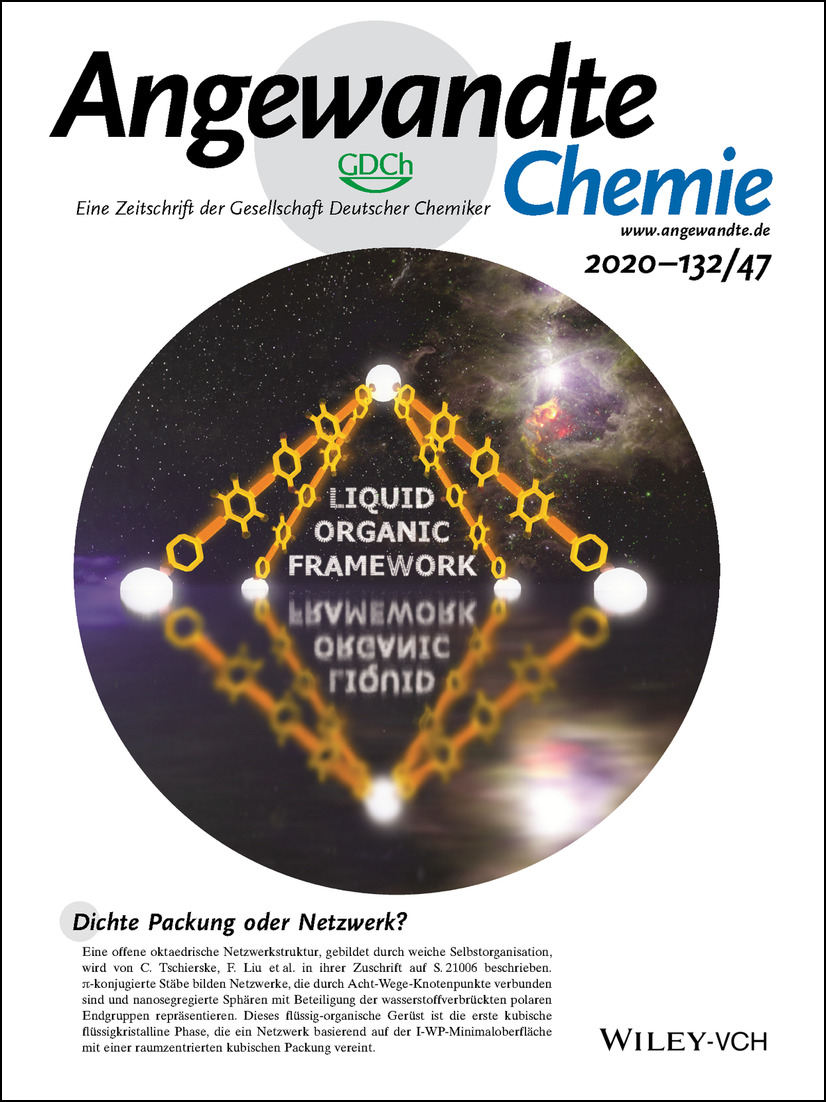
Dichte Packung oder Netzwerk? Eine offene oktaedrische Netzwerkstruktur, gebildet durch weiche Selbstorganisation, wird von C. Tschierske, F. Liu et al. in ihrer Zuschrift auf S. 21006 beschrieben. π-konjugierte Stäbe bilden Netzwerke, die durch Acht-Wege-Knotenpunkte verbunden sind und nanosegregierte Sphären mit Beteiligung der wasserstoffverbrückten polaren Endgruppen repräsentieren. Dieses flüssig-organische Gerüst ist die erste kubische flüssigkristalline Phase, die ein Netzwerk basierend auf der I-WP-Minimaloberfläche mit einer raumzentrierten kubischen Packung vereint.
Frontispiz
Frontispiz: Catalytic Asymmetric Synthesis of the anti-COVID-19 Drug Remdesivir
- First Published: 09 November 2020
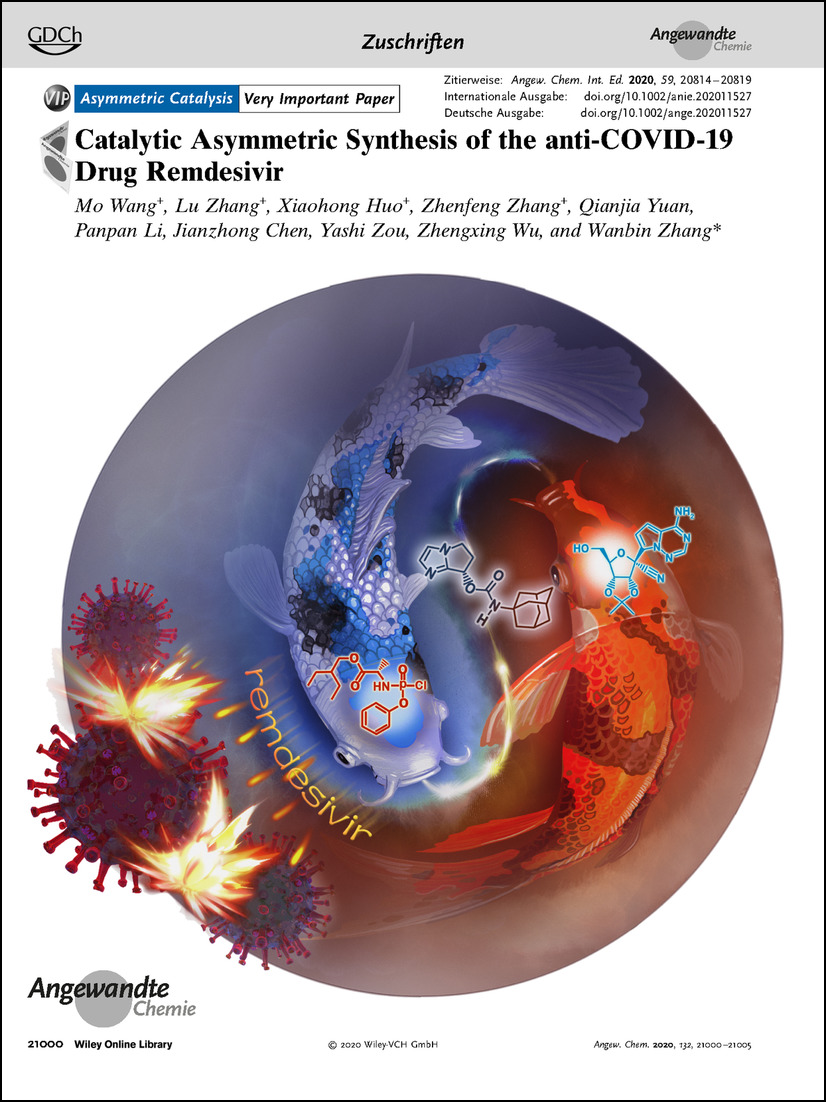
Asymmetrische Synthese Die erste katalytische asymmetrische Synthese von Remdesivir durch die Kupplung von P-racemischem Phosphorylchlorid mit dem geschützten Nukleosid GS441524 wird von W. Zhang et al. in der Zuschrift auf S. 21000 vorgestellt.
Frontispiz: Gas-Phase Ion Fluorescence Spectroscopy of Tailor-made Rhodamine Homo- and Heterodyads: Quenching of Electronic Communication by π-Conjugated Linkers
- First Published: 09 November 2020
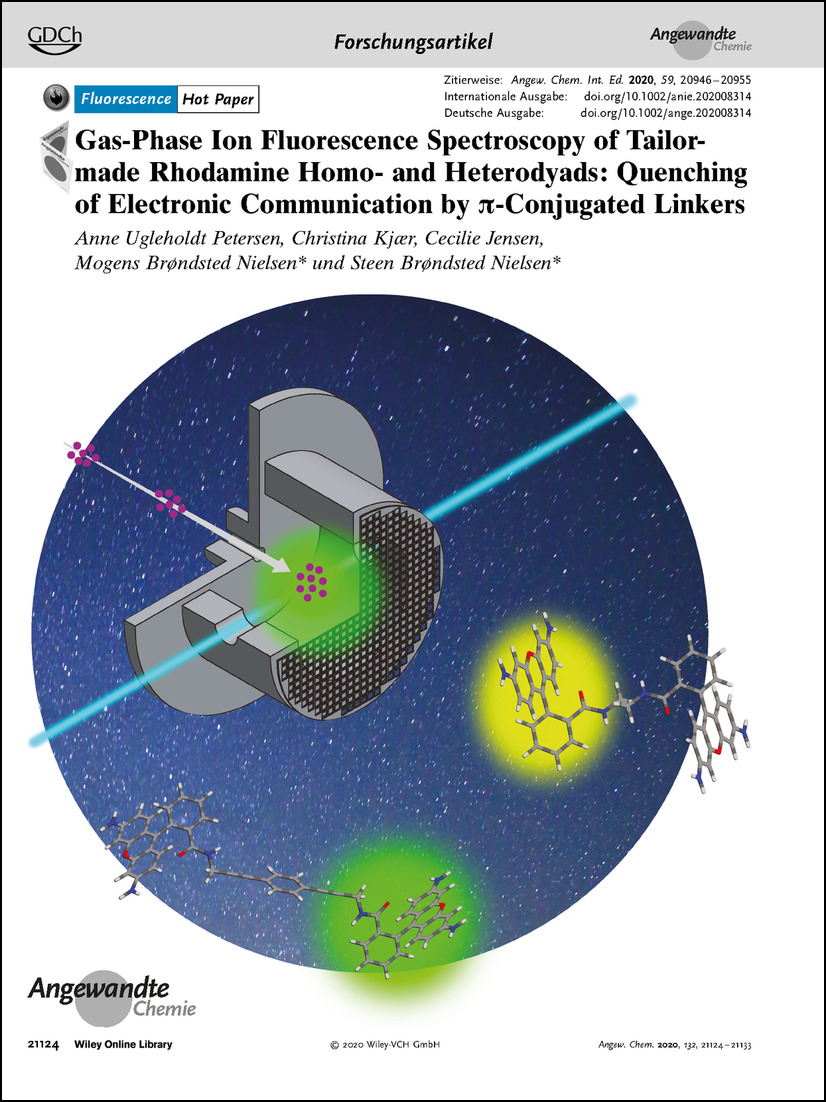
Photophysik Im Forschungsartikel auf S. 21132 berichten M. Brøndsted Nielsen, S. Brøndsted Nielsen et al. über die Gasphasen-Ionenfluoreszenzspektroskopie von gezielt hergestellten Rhodaminhomo- und Rhodaminheterodyaden.
Graphisches Inhaltsverzeichnis
Graphisches Inhaltsverzeichnis: Angew. Chem. 47/2020
- Pages: 20901-20919
- First Published: 09 November 2020
Autoren-Profil
Essays
Nikolai Zelinsky
Nikolay Zelinsky (1861–1953): Mendeleev's Protege, a Brilliant Scientist, and the Top Soviet Chemist of the Stalin Era
- Pages: 20928-20936
- First Published: 03 September 2020

Nikolay Zelinsky was one of the leading chemists worldwide at the beginning of the 20th century. He discovered four reactions that bear his name and his work formed the basis for the petrochemical industry in the Soviet Union. This Essay looks back at his achievements and sets the historical context.
Kurzaufsätze
CRISPR
CRISPR Mediated Biosensing Toward Understanding Cellular Biology and Point-of-Care Diagnosis
- Pages: 20938-20950
- First Published: 10 June 2020
Graphene Oxide
Graphene Oxide as a Mediator in Organic Synthesis: a Mechanistic Focus
- Pages: 20951-20962
- First Published: 09 June 2020
Polyoxometalates
Polyoxometalate-Based Compounds for Photo- and Electrocatalytic Applications
- Pages: 20963-20977
- First Published: 07 July 2020

Polyoxometalate chemistry has shown great application potential in the field of catalysis. This Minireview outlines and discusses the advantages, recent advances, challenges, strategies and future development of POM-based compounds as photo/electrocatalysts in hydrogen evolution reaction, oxygen evolution reaction, and CO2 reduction reaction.
Aufsätze
Wasserstoffentwicklungsreaktion
Design aktiver atomarer Zentren für HER-Elektrokatalysatoren
- Pages: 20978-20998
- First Published: 07 January 2020
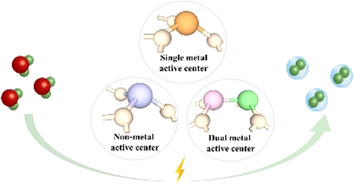
Aktiv beforscht: Dieser Aufsatz gibt einen Überblick über Methoden zur Untersuchung von HER-aktiven atomaren Zentren und diskutiert aktive Zentren mit verschiedenen Koordinationsumgebungen. Aktive Zentren mit einem Metallatom, mit zwei unterschiedlichen Metallatomen und mit Nichtmetallatomen werden auf atomarer Ebene analysiert. Abschließend werden zukünftige Forschungsrichtungen beleuchtet. HER=Wasserstoffentwicklungsreaktion.
Zuschriften
Asymmetric Catalysis | Very Important Paper
Catalytic Asymmetric Synthesis of the anti-COVID-19 Drug Remdesivir
- Pages: 21000-21005
- First Published: 01 September 2020

The first catalytic asymmetric synthesis of Remdesivir by the coupling of the P-racemic phosphoryl chloride with protected nucleoside GS441524 has been realized using a chiral bicyclic imidazole catalyst, which is crucial for the racemization process involving the phosphoryl chloride and subsequent stereodiscriminating step (96 % conv., 22:1 SP:RP). Furthermore, a 10 gram scale reaction was successfully realized, showing its potential for industrial application.
Liquid Organic Frameworks | Hot Paper
Liquid Organic Frameworks: A Liquid Crystalline 8-Connected Network with Body-Centered Cubic Symmetry
- Pages: 21006-21011
- First Published: 21 July 2020
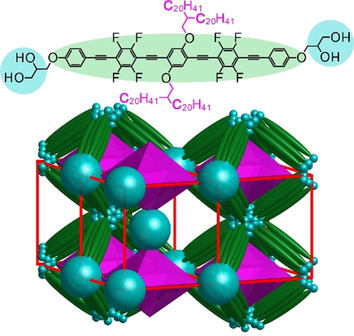
The first 8-connected network based on the I-WP minimal surface is formed by dynamic soft self-assembly of X-shaped polyphiles with oligo(para-phenylene-ethynylene) cores. This Im m cubic liquid-crystalline phase is one of a new kind of cubic phases combining a network structure of rod-bundles interconnected by polar spheres.
m cubic liquid-crystalline phase is one of a new kind of cubic phases combining a network structure of rod-bundles interconnected by polar spheres.
Electrochemistry
Selective Methanol-to-Formate Electrocatalytic Conversion on Branched Nickel Carbide
- Pages: 21012-21016
- First Published: 06 August 2020
Synthetic Methods
para-Selective Arylation of Arenes: A Direct Route to Biaryls by Norbornene Relay Palladation
- Pages: 21017-21022
- First Published: 04 August 2020

The para-selective arylation of sulfonate, phosphonate, and phenol derivatives bearing 2,6-disubstitution patterns and a suitable meta-directing group is achieved by using Pd and norbornene cooperative catalysis. The present protocol enables the synthesis of hexa-substituted arenes by sequential regioselective C−H functionalization.
Biomolecular Condensates
Determinants for Fusion Speed of Biomolecular Droplets
- Pages: 21023-21026
- First Published: 07 August 2020

The tendency of biomolecular droplets to fuse is key to cellular functions and diseases. Using optical tweezers, fluorescence microscopy, and theoretical modeling, we have begun to unravel the molecular origin for disparate fusion speeds among different biomolecular droplets. Fusion speed is dictated by macromolecular packing density inside droplets, which can be reported by thioflavin T fluorescence.
Asymmetric Synthesis
Enantioselective Synthesis of β-Amino Acid Derivatives Enabled by Ligand-Controlled Reversal of Hydrocupration Regiochemistry
- Pages: 21027-21031
- First Published: 29 June 2020

The regioselectivity of the hydrocupration of α,β-unsaturated carbonyl compounds can be reversed in the presence of an appropriate ancillary chiral ligand. This ligand-controlled reversal of regiochemistry enables enantioselective and β-selective hydroamination of α,β-unsaturated carbonyl compounds, with 1,2-benzisoxazole as an electrophilic aminating reagent, thereby providing simple and efficient access to N-unprotected β-amino acid derivatives.
Molecular Cages
Desymmetrized Vertex Design toward a Molecular Cage with Unusual Topology
- Pages: 21032-21037
- First Published: 07 August 2020
Synthesis
Halogen-Imparted Reactivity in Lithium Carbenoid Mediated Homologations of Imine Surrogates: Direct Assembly of bis-Trifluoromethyl-β-Diketiminates and the Dual Role of LiCH2I
- Pages: 21038-21043
- First Published: 31 July 2020

The treatment of a trifluoroacetimidoyl chloride (TFAIC) with the carbenoid iodomethyllithium results in the chemoselective formation of a bis-trifluoromethyl-β-diketiminate. This sequential two-events strategy involves the homologation of the imine surrogate followed by the lithiation of the intermediate operated by the same carbenoid and attack of a second TFAIC unit.
Membrane Gas Separation | Very Important Paper
Anisotropic Gas Separation in Oriented ZIF-95 Membranes Prepared by Vapor-Assisted In-Plane Epitaxial Growth
- Pages: 21044-21048
- First Published: 07 August 2020

A thin and well-intergrown zeolitic imidazolate framework (ZIF-95) membrane was developed for H2 separation. A simple vapor-assisted in-plane epitaxial growth method generated a highly oriented ZIF-95 membrane. A notable reduction of intercrystalline defects and transport pathways was achieved compared to a randomly oriented ZIF-95 framework, resulting in a 4.6 times enhancement of H2 permeance for the separation of H2 (0.29 nm) from larger gas molecules.
Metal–Ligand Cooperation
Reversible Hydride Migration from C5Me5 to RhI Revealed by a Cooperative Bimetallic Approach
- Pages: 21049-21053
- First Published: 31 July 2020

The reversible migration of hydrogen atoms from methyl groups of the ubiquitous C5Me5 (Cp*) ligand to the RhI center in [(η5-C5Me5)Rh(PMe3)2] is demonstrated, revealing the potential role of Cp* as a proton shuttle by a route that was previously restricted to early transition metals. The incorporation of bulky and electrophilic gold fragments allows the isolation of key bimetallic species in support of the reversible C−H activation at Cp*.
Supramolecular Chemistry
Tetra-benzothiadiazole-based [12]Cycloparaphenylene with Bright Emission and Its Supramolecular Assembly
- Pages: 21054-21058
- First Published: 04 August 2020
![Tetra-benzothiadiazole-based [12]Cycloparaphenylene with Bright Emission and Its Supramolecular Assembly](/cms/asset/4649ac72-1436-4de5-a5bf-17f4455fca45/ange202008505-toc-0001-m.jpg)
A benzothiadiazole-based [12]cycloparaphenylene (TB[12]CPP) is obtained and characterized. TB[12]CPP exhibits a lime to orange emission with a quantum yield up to 98 %, ranking it as one of the brightest CPPs. As a supramolecular host, TB[12]CPP is bright as well, showing adaptable ring structure. A ternary assembly between TB[12]CPP, fullerene, and buckybowl is realized.
Metal–Organic Frameworks | Hot Paper
Paramagnetic Conducting Metal–Organic Frameworks with Three-Dimensional Structure
- Pages: 21059-21064
- First Published: 04 August 2020
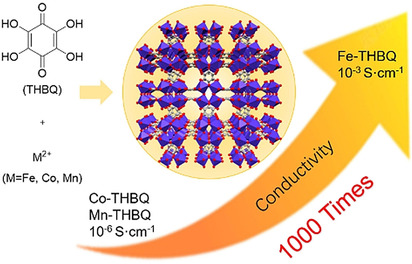
Three MOFs with high crystallinity were synthesized from the conjugated ligand tetrahydroxybenzoquinone (THBQ) and Fe, Co, Mn metal ions. Fe-THBQ has a negative Seebeck coefficient and the highest electrical conductivity in THBQ-based MOFs, which could be due to the FeII/FeIII mixed valence. Strong absorptions in the visible light region provide the possibility of application in the light-harvesting devices.
Heterogeneous Catalysis
Tuning the Reactivity of a Heterogeneous Catalyst using N-Heterocyclic Carbene Ligands for C−H Activation Reactions
- Pages: 21065-21070
- First Published: 28 July 2020

The addition of N-heterocyclic carbenes on Ru/C induces a catalytic activity switch to favor hydrogen isotope exchange over reductive deuteration. This catalyst modification led to an increase in regio- and chemoselectivity in the context of the C−H deuteration of pharmaceutically relevant substructures, as well as to the discovery of a novel reactivity for such heterogeneous Ru catalysts, namely selective C-1 deuteration of aldehydes.
Deracemization
Enantiospecific Solid Solution Formation Triggers the Propagation of Homochirality
- Pages: 21071-21075
- First Published: 11 August 2020

An enantiomerically pure additive can direct chiral symmetry breaking towards opposite outcomes, depending on the relative contributions of kinetic and thermodynamic processes. Kinetic growth inhibition directs symmetry breaking towards the enantiomer of the opposite configuration to the additive, whereas thermodynamic solid solution formation favors the same absolute configuration, thus offering a mechanism for the propagation of homochirality.
Electroanalysis | Hot Paper
A Multifunctional Microfluidic Platform for High-Throughput Experimentation of Electroorganic Chemistry
- Pages: 21076-21080
- First Published: 06 August 2020

An automated electrochemistry screening platform based on a single-droplet microfluidic reactor enables multifunctional capabilities for investigation of electroorganic synthesis. Reaction condition screening of an electrochemical radical–radical cross-coupling reaction and measurements of kinetics for two mediated anodic oxidation reactions are realized with fast turnover time and minimal reagent consumption.
Gene Editing
Optical Control of a CRISPR/Cas9 System for Gene Editing by Using Photolabile crRNA
- Pages: 21081-21085
- First Published: 28 July 2020

Caged crRNA was readily developed through a terminus modification with a photolabile linker and vitamin E for construction of a caged CRISPR/Cas9 system. The system was successfully used for photomodulation of VEGFA gene editing and control of EGFP gene silencing through the temporary inhibition of the interaction between the target DNA and Cas9/crRNA/tracrRNA complex.
Bond Analysis
The Na⋅⋅⋅B Bond in NaBH3−: A Different Type of Bond
- Pages: 21086-21089
- First Published: 05 August 2020
Organocatalysis
Enantioselective Intramolecular [2,3]-Sigmatropic Rearrangement of Aldehydes via a Sulfonium Enamine Intermediate
- Pages: 21090-21094
- First Published: 05 August 2020
![Enantioselective Intramolecular [2,3]-Sigmatropic Rearrangement of Aldehydes via a Sulfonium Enamine Intermediate](/cms/asset/a04fd722-2d79-4cda-87eb-cea89f3c389e/ange202010234-toc-0001-m.jpg)
An organocatalytic enantioselective [2,3]-sigmatropic rearrangement is described. This reaction enables chiral cyclic sulfides bearing an α-quaternary chiral center to be prepared in high optical purity. The enantioselectivity is controlled by a cooperative organocatalyst pair consisting of a chiral amine and a chiral phosphoric acid (CPA). NIS=N-iodosuccinimide.
Nanoparticles
Utilizing a Photocatalysis Process to Achieve a Cathode with Low Charging Overpotential and High Cycling Durability for a Li-O2 Battery
- Pages: 21095-21099
- First Published: 05 August 2020
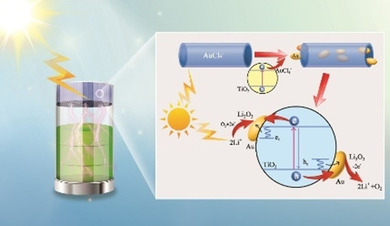
The Li-O2 battery can be photoactivated, thus reducing the recharge potential to 2.7 V with a binder- and carbon-free TiO2-based oxygen electrode, which also enhances the stability of the system. The electrode exhibits excellent stability with about 100 % coulombic efficiency during continuous cycling of up to 200 cycles. This work reveals a new strategy towards the development of highly efficient oxygen electrode materials for Li-O2 batteries.
Main-Group Chemistry | Hot Paper
A Phosphanyl-Phosphagallene that Functions as a Frustrated Lewis Pair
- Pages: 21100-21104
- First Published: 02 July 2020
Water Splitting
LaOCl-Coupled Polymeric Carbon Nitride for Overall Water Splitting through a One-Photon Excitation Pathway
- Pages: 21105-21109
- First Published: 11 August 2020
Inorganic Chemistry | Hot Paper
Enantioselective Crystallization of Chiral Inorganic Crystals of ϵ-Zn(OH)2 with Amino Acids
- Pages: 21110-21115
- First Published: 09 August 2020
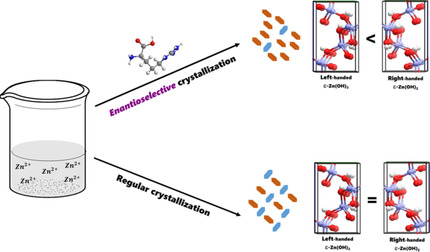
Chiral crystals of ϵ-Zn(OH)2 were crystallized from supersaturated aqueous solutions in the presence of l- or d-arginine and chiral discrimination was observed during the crystallization. A new method for identifying chirality in crystals by using electron paramagnetic resonance (EPR) has also been developed.
Superacids | Hot Paper
Bis(perchlorocatecholato)germane: Hard and Soft Lewis Superacid with Unlimited Water Stability
- Pages: 21116-21120
- First Published: 10 August 2020
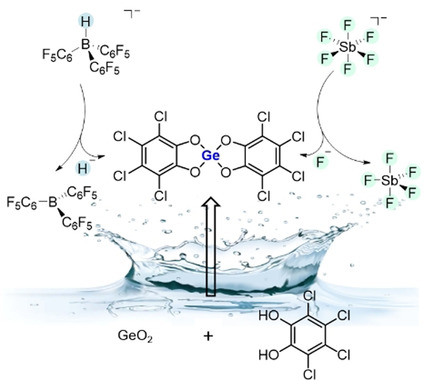
Bis(perchlorocatecholato)germane is a hard and soft Lewis superacid with unlimited water stability. Its utility in catalysis as both a Lewis and Brønsted acid was demonstrated by application to a variety of catalytic transformations, such as hydrodefluorination, hydrosilylation, transfer hydrogenation, and carbonyl–olefin metathesis.
Keton-Aktivierung
α-Funktionalisierung von Ketonen durch metallfreie elektrophile Aktivierung
- Pages: 21121-21125
- First Published: 11 September 2020

Elektrophile Ketonaktivierung: Die Tf2O-vermittelte Aktivierung von Acetophenonen führt zu außerordentlich elektrophilen Intermediaten, welche eine Vielzahl an Transformationen mit Nukleophilen durchlaufen können. Diese Methode ermöglicht den Zugang zu α-arylierten and α-oxyaminierten Acetophenonen unter metallfreien Bedingungen in mittleren bis ausgezeichneten Ausbeuten.
Biotechnologie
Die Erzeugung von Tyrosinaseaktivität in einer Catecholoxidase erlaubt die Identifizierung der für die C-H-Aktivierung in Typ-III-Kupferenzymen verantwortlichen Aminosäurereste
- Pages: 21126-21131
- First Published: 23 July 2020
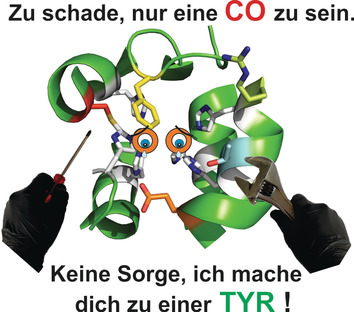
Es wird gezeigt, dass die konservierten Histidine (HisA2, HisB1 und HisB2), die von benachbarten Resten (HisB1+1, HisB2+1 und dem Wasserträger) beeinflusst werden, für die Hydroxylaseaktivität verantwortlich sind. Ausgehend von einer Catecholoxidase (CO) wurde eine Tyrosinase (TYR) mit starker, klar im Bereich natürlich vorkommender pflanzlicher TYRs liegender Monophenolaseaktivität entwickelt.
Forschungsartikel
Fluorescence | Hot Paper
Gas-Phase Ion Fluorescence Spectroscopy of Tailor-made Rhodamine Homo- and Heterodyads: Quenching of Electronic Communication by π-Conjugated Linkers
- Pages: 21132-21141
- First Published: 13 August 2020
Singlet Fission | Very Important Paper
Multiexcitonic Triplet Pair Generation in Oligoacene Dendrimers as Amorphous Solid-State Miniatures
- Pages: 21142-21150
- First Published: 07 July 2020
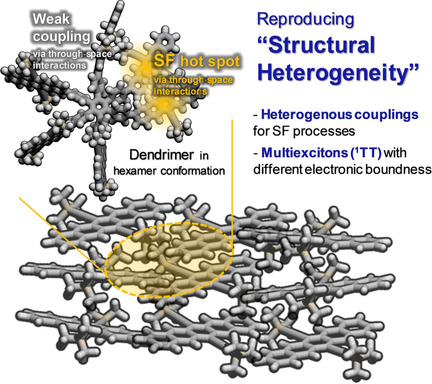
Heterogeneous couplings and energetics for singlet fission (SF) processes were developed in dendritic structures which mimic complicated SF dynamics in amorphous solids. SF in dendritic structures was thoroughly investigated by time-resolved spectroscopic techniques and quantum chemical calculations in respect of relative orientation/distance between chromophores and through-bond/-space interactions.
Membrane Protein Dynamics
Dynamics of Bacteriorhodopsin in the Dark-Adapted State from Solution Nuclear Magnetic Resonance Spectroscopy
- Pages: 21151-21158
- First Published: 29 July 2020

Nuclear magnetic resonance (NMR) spectroscopy was employed to monitor methyl relaxation in the side chains of the light-driven proton pump bacteriorhodopsin (bR) and its less active M145A mutant. The findings provide a detailed picture of equilibrium dynamics on different time scales for ground-state bR.
Heterogeneous Catalysis | Hot Paper
Scaling Platinum-Catalyzed Hydrogen Dissociation on Corrugated Surfaces
- Pages: 21159-21165
- First Published: 04 August 2020
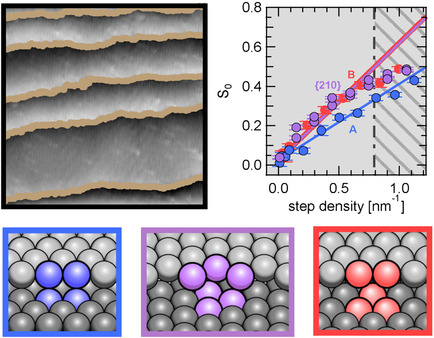
Curved platinum single crystals provide stepped surface arrays featuring terraces, steps, and kinks. Linking the structural elements of these surfaces to their chemical activity towards hydrogen dissociation provides new insights into the scalability of reactivity at low-coordinated sites, such as those featured on heterogeneous catalyst particles.
Perovskite Solar Cells | Hot Paper
Suppressing Interfacial Charge Recombination in Electron-Transport-Layer-Free Perovskite Solar Cells to Give an Efficiency Exceeding 21 %
- Pages: 21166-21173
- First Published: 27 July 2020
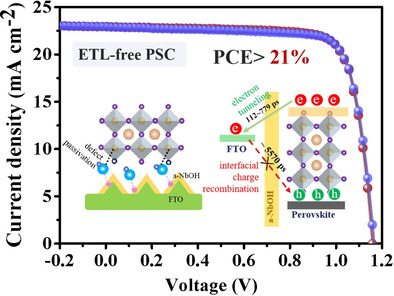
A non-annealed, ultrathin, amorphous metal oxyhydroxide was introduced to suppress interfacial charge recombination and reduce energy loss in electron-transport-layer (ETL)-free perovskite solar cells. The cells achieve a record efficiency of 21.1 %, outperforming their ETL-containing metal oxide counterparts (18.7 %).
Coordination Polymers | Hot Paper
A General Strategy for Hollow Metal-Phytate Coordination Complex Micropolyhedra Enabled by Cation Exchange
- Pages: 21174-21181
- First Published: 12 August 2020
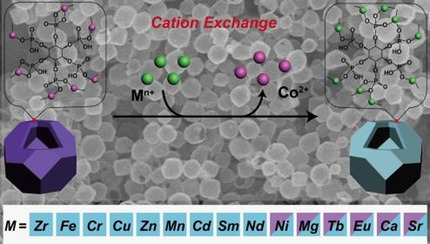
The cation exchanged synthesis of diverse hollow metal-phytate (PA) polyhedral complexes is reported using hollow Co2+-PA micropolyhedra as templates in a liquid phase. The synthetic strategy enables facile addition of multiple functionalities within the metal-PA polyhedral networks with simultaneous control of their physicochemical features under mild conditions.
Fluorescent Probes
An Acid-Activatable Fluorescence Probe for Imaging Osteocytic Bone Resorption Activity in Deep Bone Cavities
- Pages: 21182-21186
- First Published: 03 August 2020

A pH-activatable fluorescent probe (pHocas-RIS) with moderate bone-binding affinity was synthesized by conjugating a BODIPY fluorophore to bisphosphonate-targeting risedronate ligands. The probe enabled the imaging of acidic osteocytic lacunae that contain bone resorbing osteocytes in deep bone tissues in living animals.
Olefin Separation | Hot Paper
Overcoming Fundamental Limitations in Adsorbent Design: Alkene Adsorption by Non-porous Copper(I) Complexes
- Pages: 21187-21192
- First Published: 25 August 2020
Protein Modifications | Hot Paper
In Cellulo Protein Semi-Synthesis from Endogenous and Exogenous Fragments Using the Ultra-Fast Split Gp41-1 Intein
- Pages: 21193-21201
- First Published: 10 August 2020
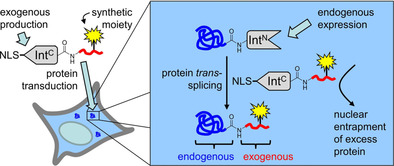
To chemically modify proteins inside cells with an exogenously prepared, labeled backbone fragment, we have explored the fastest splicing split intein. Excess intein reagent is removed to the nucleus to increase the signal-to-noise ratio in the cytoplasm. We report synthetic fluorophore attachment for super-resolution and single-molecule tracking studies.
Carbohydrate Recognition | Hot Paper
Rational Design of a DNA-Scaffolded High-Affinity Binder for Langerin
- Pages: 21202-21208
- First Published: 04 August 2020
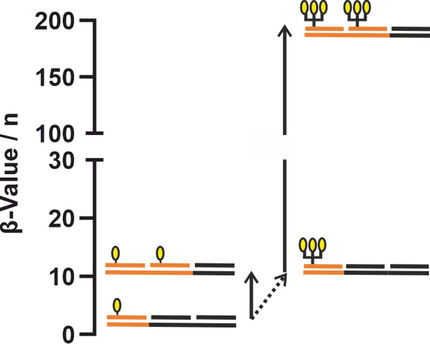
Statistical rebinding and chelate binding reinforce each other and cooperatively increase the affinity for a multivalent target. The distance-defined display of two small clusters of a glycomimetic compound on a rigid PNA-DNA scaffold provided the first molecularly defined, nanomolar binder of the C-type lectin receptor langerin. The high-affinity binders are selectively internalized by langerin-expressing cells.
OLEDs
Design Strategy Towards Horizontally Oriented Luminescent Tetradentate-Ligand-Containing Gold(III) Systems
- Pages: 21209-21217
- First Published: 04 August 2020
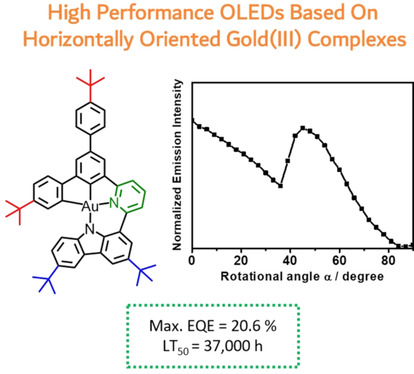
A novel class of tetradentate C^C^N^N ligand-containing gold(III) complexes with a preferential horizontal orientation has been obtained through a one-pot reaction. A high maximum external quantum efficiency of 20.6 % has been realized in the vacuum-deposited gold(III)-based OLEDs, with operational half-lifetimes of around 37 500 h at 100 cd m−2.
Nanomedicine
Near-Infrared Light-Triggered Chlorine Radical (.Cl) Stress for Cancer Therapy
- Pages: 21218-21226
- First Published: 15 July 2020

A chlorine radical (.Cl) nano-generator is constructed with a SiO2-coated upconversion nanoparticle (UCNP) interior and decorated with Ag0/AgCl hetero-dots on the outside. Upon NIR light irradiation, the emission light of the UCNPs activates Ag0/AgCl to catalyze Cl− production, generating .Cl. The resulting radicals have strong oxidizing capacity and nucleophilicity, leading to efficient tumor therapy without dependence on O2 and H2O2.
Nanoassemblies
Tumor Microenvironment Stimuli-Responsive Fluorescence Imaging and Synergistic Cancer Therapy by Carbon-Dot–Cu2+ Nanoassemblies
- Pages: 21227-21234
- First Published: 11 September 2020
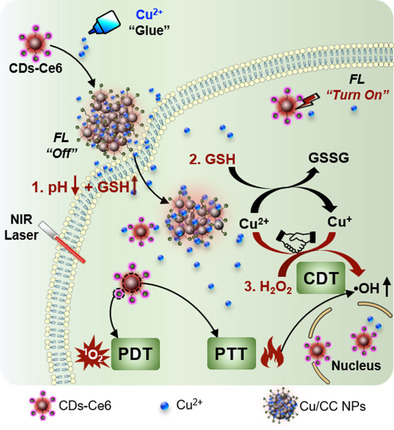
A tumor microenvironment (TME) stimuli-responsive fluorescence imaging and trimodal synergistic cancer treatment nanoplatform is facilely constructed via assembling carbon dots and Cu2+. This could act as a potential strategy to achieve enhanced cancer therapeutic efficiency with minimized side effects.
Fluorescent Probes | Very Important Paper
Fluorination Enhances NIR-II Fluorescence of Polymer Dots for Quantitative Brain Tumor Imaging
- Pages: 21235-21243
- First Published: 07 August 2020
DNA Nanotechnology
Disulfide-Linked Allosteric Modulators for Multi-cycle Kinetic Control of DNA-Based Nanodevices
- Pages: 21244-21249
- First Published: 08 August 2020

We describe a DNA-based nanodevice that acts as a sulfur switch and can be temporally controlled through redox cycles of a disulfide-linked allosteric modulator. The system has an unprecedented high tolerance to waste products and displays transient behavior for over 40 cycles without significant loss of efficiency. The approach is reversible and allows the transient loading and release of a ligand upon successive reduction and oxidation of the modulator.
Amination Reactions | Very Important Paper
Design and Scalable Synthesis of N-Alkylhydroxylamine Reagents for the Direct Iron-Catalyzed Installation of Medicinally Relevant Amines
- Pages: 21250-21257
- First Published: 06 August 2020
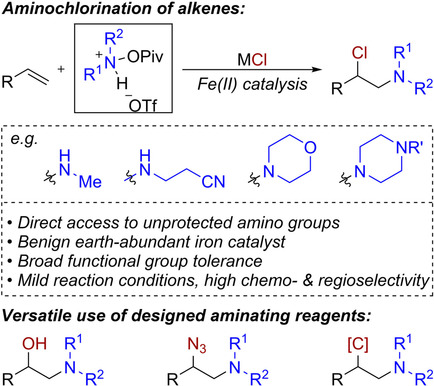
The direct synthesis of unprotected secondary and tertiary alkylamines from alkenes is reported. Aminative difunctionalization was mediated by an iron catalyst to yield a family of ten hydroxylamine-derived aminating reagents. Several medicinally relevant amine groups, such as methylamine, morpholine and piperazine, were installed through the aminochlorination, -hydroxylation, -azidation and carboamination of alkenes.
CO2 Reduction
Electrochemical Reduction of Carbon Dioxide to 1-Butanol on Oxide-Derived Copper
- Pages: 21258-21265
- First Published: 24 July 2020
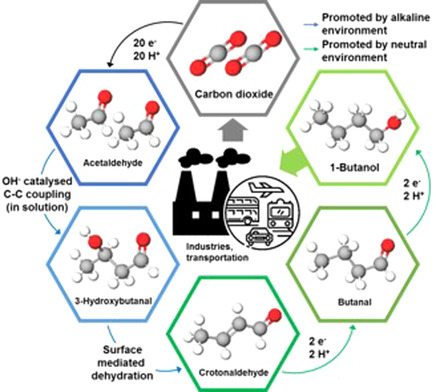
Carbon dioxide was electroreduced to 1-butanol on oxide-derived copper. The reaction mechanism was determined to proceed through a combination of electrochemical and chemical steps, some of which require contrasting conditions. This example highlights limitations in one-pot synthesis and provides a case for utilizing independently optimized sequential reactors in a tandem system to build complex molecules from low molecular-weight feedstocks.
Nanomotors
Enzyme Conformation Influences the Performance of Lipase-powered Nanomotors
- Pages: 21266-21273
- First Published: 04 August 2020
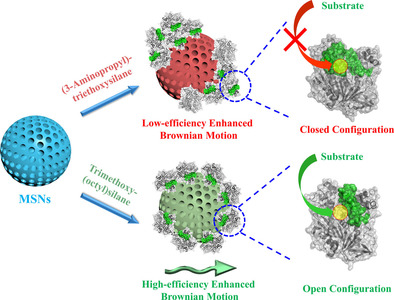
The impact of enzyme orientation on the performance of lipase-powered nanomotors was explored and analysed, indicating that hydrophobic interaction is the best strategy for immobilizing lipase to provide high-efficiency catalysis. This results in a high-efficiency enhanced Brownian motion, which would be vital in promoting the future applications of enzyme-powered micro/nanomotors.
Cross-Coupling
Oxidative Addition of Water, Alcohols, and Amines in Palladium Catalysis
- Pages: 21274-21281
- First Published: 03 August 2020

The oxidative addition of OH, NH, and weak CH bonds to a palladium(0) complex is facile, allows for additive-free catalysis, and suggests the non-innocence of water in palladium catalysis. The oxidative addition of protic solvents or adventitious water switches the chemoselectivity in catalysis with alkynes through activation of the terminal C−H bond.
Drug Discovery
A Photoaffinity-Based Fragment-Screening Platform for Efficient Identification of Protein Ligands
- Pages: 21282-21291
- First Published: 03 August 2020

PhotoAffinity Bit (PhABit) is a photoreactive fragment-screening platform to covalently capture fragment–protein interactions. Hits can be profiled and subsequently developed as reporters in a competitive displacement assay to identify novel hit matter. The PhABit platform is widely applicable to novel protein targets, identifying starting points in the development of therapeutics.
Water Splitting
Adaptive Bifunctional Electrocatalyst of Amorphous CoFe Oxide @ 2D Black Phosphorus for Overall Water Splitting
- Pages: 21292-21299
- First Published: 06 August 2020
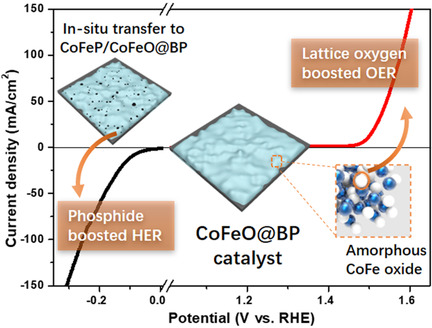
By growing amorphous multi-transition-metal (cobalt and iron) oxide on two-dimensional (2D) black phosphorus (BP), a bifunctional electrocatalyst (CoFeO@BP), which is able to efficiently catalyze both HER and OER was developed. The overpotentials for the hybrid CoFeO@BP catalyst to reach a current density of 10 mA cm−2 in 1 m KOH are 88 and 266 mV for HER and OER, respectively.
Isotope Labelling
Multiple Site Hydrogen Isotope Labelling of Pharmaceuticals
- Pages: 21300-21306
- First Published: 28 July 2020

A general method for the multiple site hydrogen isotope labelling of complex molecules using the commercially available and air-stable iridium precatalyst [Ir(COD)(OMe)]2 is reported. This new synthetic method possesses multiple key features far beyond the state-of-the-art methods for tritium labelling, including a very broad substrate scope and an exceptional functional group tolerance facilitating the access to complex pharmaceuticals with high molar activities.
Photocatalysis | Hot Paper
Visible-Light Photoredox-Catalyzed Remote Difunctionalizing Carboxylation of Unactivated Alkenes with CO2
- Pages: 21307-21314
- First Published: 04 August 2020

Reported is the first remote difunctionalization of unactivated alkenes with CO2 by visible-light photoredox catalysis. Mechanistic studies indicate that a 1,5-hydrogen atom-transfer process is the rate-limiting step and reduction of radical intermediates generates the corresponding carbanions. Other electrophiles, including aldehydes, ketones, and benzylic bromides, are also applicable in this process, demonstrating a general strategy for redox-neutral remote difunctionalization of unactivated alkenes.
Microfabrication | Very Important Paper
Direct Nanomachining on Semiconductor Wafer By Scanning Electrochemical Microscopy
- Pages: 21315-21320
- First Published: 31 July 2020
Gold Catalysis | Very Important Paper
Reactivity and Lability Modulated by a Valence Electron Moving in and out of 25-Atom Gold Nanoclusters
- Pages: 21321-21328
- First Published: 29 July 2020

The catalytic reactivity and lability of atomically precise Au25 nanoclusters was investigated by monitoring the movement of a free valence electron of the Au 6s orbital. Donation of an electron to a neutral Au250 nanocluster generates Au25− with undermined reactivity, whereas dislodgment of an electron generates Au25+ with undermined stability. The correlation of the free valence electrons and catalytic properties of the Au25 nanoclusters can be achieved at a single-electron level.
Theranostics | Very Important Paper
Spatio-Temporally Reporting Dose-Dependent Chemotherapy via Uniting Dual-Modal MRI/NIR Imaging
- Pages: 21329-21336
- First Published: 30 July 2020
Materials Science
K2Sb(P2O7)F: Cairo Pentagonal Layer with Bifunctional Genes Reveal Optical Performance
- Pages: 21337-21342
- First Published: 03 August 2020
Antitumor Agents
A Multi-action PtIV Conjugate with Oleate and Cinnamate Ligands Targets Human Epithelial Growth Factor Receptor HER2 in Aggressive Breast Cancer Cells
- Pages: 21343-21348
- First Published: 04 August 2020
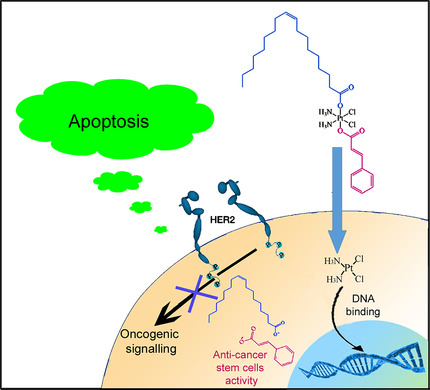
A PtIV prodrug with axial oleate and cinnamate ligands was synthesized. It is active against HER2-positive breast cancer, which is an aggressive breast-cancer subtype that typically responds poorly to standard chemotherapy. Moreover, the new PtIV prodrug is capable of overcoming the resistance of cancer stem cells (CSCs), inducing death in both CSCs and differentiated cancer cells.
Supramolecular Self-Assembly
Heterochiral Self-Discrimination-Driven Supramolecular Self-Assembly of Decanuclear Gold(I)-Sulfido Complexes into 2D Nanostructures with Chiral Anions-Tuned Morphologies
- Pages: 21349-21355
- First Published: 29 July 2020
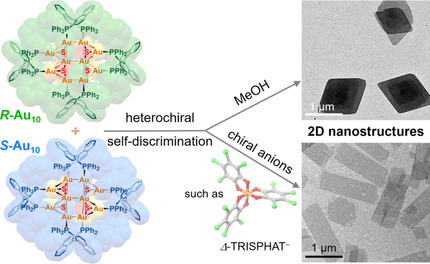
Heterochiral self-discrimination between two chiral decanuclear gold(I) enantiomers gives rise to self-assembled 2D nanostructures. The introduction of chiral anions has been shown to tune the morphology of these 2D NCs from rhombic NCs to bilayer strip and quasi-hexagonal nanosheets. The current finding provides an important alternative towards the easy fabrication of regular geometric 2D nanostructures based on polynuclear gold(I) complexes.
Electrocatalysis
Selective Transfer Semihydrogenation of Alkynes with H2O (D2O) as the H (D) Source over a Pd-P Cathode
- Pages: 21356-21361
- First Published: 10 August 2020
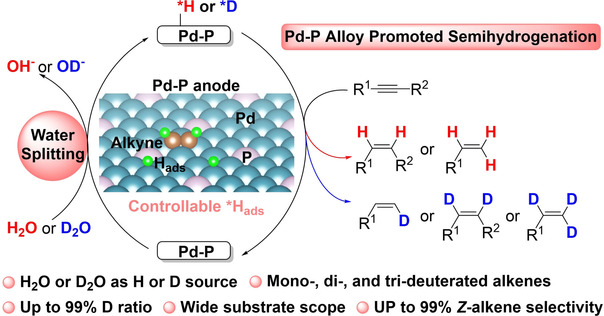
Pd-P nanostructures are efficient electrocatalysts for selective semihydrogenation (deuteration) of terminal and internal alkynes using H2O (D2O) as the H (D) source at a lower potential via an adsorbed atomic hydrogen (H*ads) addition pathway. P-doping causes enhanced specific adsorption of alkynes and promoted intrinsic activity for producing H*ads from water electrolysis.
Hydroboration
Photocontrolled Cobalt Catalysis for Selective Hydroboration of α,β-Unsaturated Ketones
- Pages: 21362-21368
- First Published: 07 August 2020
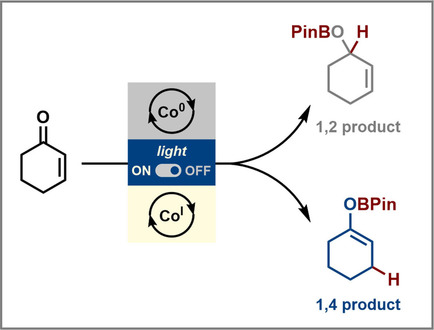
A single catalytic platform is described for which control of 1,2 versus 1,4 selectivity for enone hydroboration can be controlled by light. This was used to obtain rare syn-aldol products on cyclic substrates. Experiments and DFT calculations demonstrate that two distinctive mechanisms are operative.
Surface Interactions | Very Important Paper
Modulating Orientational Order to Organize Polyhedral Nanoparticles into Plastic Crystals and Uniform Metacrystals
- Pages: 21369-21375
- First Published: 07 August 2020
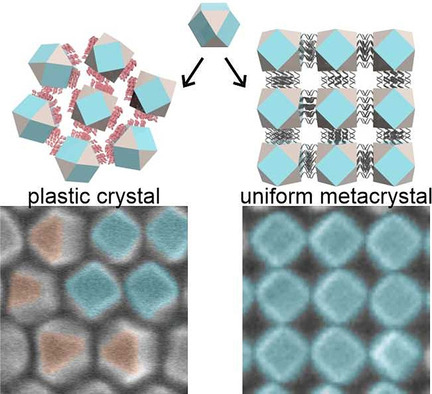
Gaining control over the orientational order of nanoparticles, and by extension the formation of plastic crystals over large areas, remains challenging. Molecular-level polymeric surface interactions are now employed to modulate the orientational order of Archimedean nanoparticles. Two orientationally distinct supercrystals are formed using a single nanoparticle shape, including plastic crystals and uniform metacrystals.
DNA Nanotechnology | Hot Paper
Cut and Paste for Cancer Treatment: A DNA Nanodevice that Cuts Out an RNA Marker Sequence to Activate a Therapeutic Function
- Pages: 21376-21380
- First Published: 20 July 2020
Organocatalysis
Radical-Cation Cascade to Aryltetralin Cyclic Ether Lignans Under Visible-Light Photoredox Catalysis
- Pages: 21381-21388
- First Published: 03 August 2020
Magnetic Properties | Hot Paper
Quantification of the Magnetic Anisotropy of a Single-Molecule Magnet from the Experimental Electron Density
- Pages: 21389-21395
- First Published: 30 July 2020
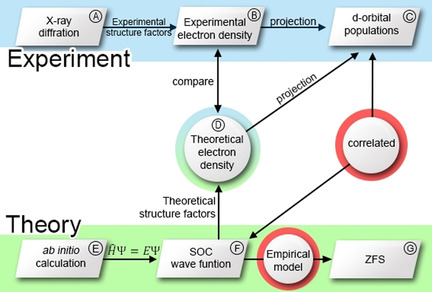
The experimental electron density obtained from 20 K synchrotron X-ray diffraction data was used here to quantify the zero-field splitting parameter in a CoII-based single-molecule magnet. The methodology uses the d-orbital populations to derive the ground-state wavefunction composition, which is shown to be strongly correlated to the zero-field splitting.
Total Synthesis
Total Synthesis of Zephycarinatines via Photocatalytic Reductive Radical ipso-Cyclization
- Pages: 21396-21401
- First Published: 07 August 2020

Total synthesis of the plicamine-type alkaloids, zephycarinatines C and D has been achieved. The key feature of the synthesis is a stereoselective radical ipso-cyclization using visible-light-mediated photoredox catalysis. Biological evaluation of zephycarinatines and their derivatives revealed that a synthetic derivative displays moderate inhibitory activity against LPS-induced NO production.
Methane Reforming
Photoassisted Selective Steam and Dry Reforming of Methane to Syngas Catalyzed by Rhodium–Vanadium Bimetallic Oxide Cluster Anions at Room Temperature
- Pages: 21402-21409
- First Published: 06 August 2020
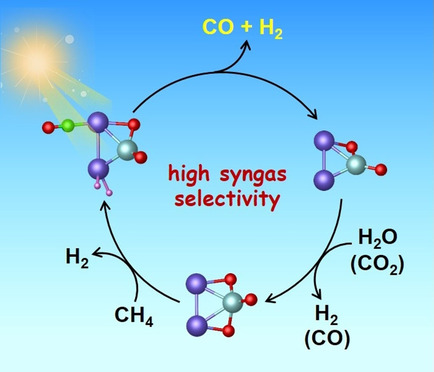
Steam and dry reforming of methane catalyzed by gas-phase rhodium–vanadium–oxygen cluster anions at room temperature with high syngas selectivity has been identified under photo-irradiation conditions. The crucial step to govern syngas selectivity is the photo-excitation of reaction intermediates such as Rh2VO3CH2− to electronically excited states that selectively produce H2 and CO.
Photoracemization | Hot Paper
Enabling Racemization of Axially Chiral Subphthalocyanine-Tetracyanobutadiene-Aniline Enantiomers by Triplet State Photogeneration
- Pages: 21410-21415
- First Published: 04 August 2020
Oberflächenchemie | Hot Paper
Kooperative Zusammenarbeit von N-heterocyclischen Carbenen auf einer Goldoberfläche
- Pages: 21416-21422
- First Published: 21 August 2020
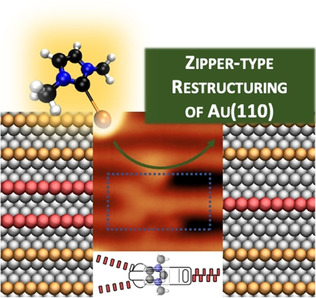
Auf N-heterocyclischen Carbenen basierende molekulare „Ballbots“ modifizieren eine Goldoberfläche mit atomarer Genauigkeit. Die molekularen Spezies bilden nicht nur atomar präzise Oberflächendefekte, sondern sie können kooperativ zusammenarbeiten, um die Oberfläche reißverschlussartig umzustrukturieren. Der Operationsmechanismus bietet einen neuen Ansatz zur Anpassung sowohl der lokalen als auch der weitreichenden Struktur von Goldoberflächen.
Chalkogenbindung
Die Natur starker Chalkogenbindungen unter Beteiligung chalkogenhaltiger Heterocyclen
- Pages: 21423-21430
- First Published: 10 August 2020
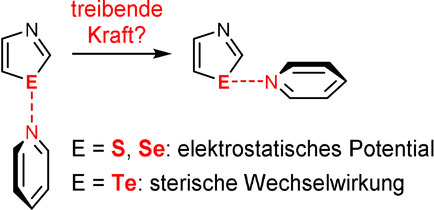
SAPT-Berechnungen von Chalkogenbindungen zeigen, dass weder der induktive (Delokalisierungseffekte) noch der elektrostatische Term die räumliche Orientierung starker Chalkogenbindungen in tellurhaltigen Aromaten verursacht. Stattdessen sind sterische Wechselwirkungen (Pauli-Abstoßung) ausschlaggebend, was die Bedeutung der häufig übersehenen sterischen Wechselwirkungen in der Konformationskontrolle von Sigma-Hole-Wechselwirkungen unterstreicht.




